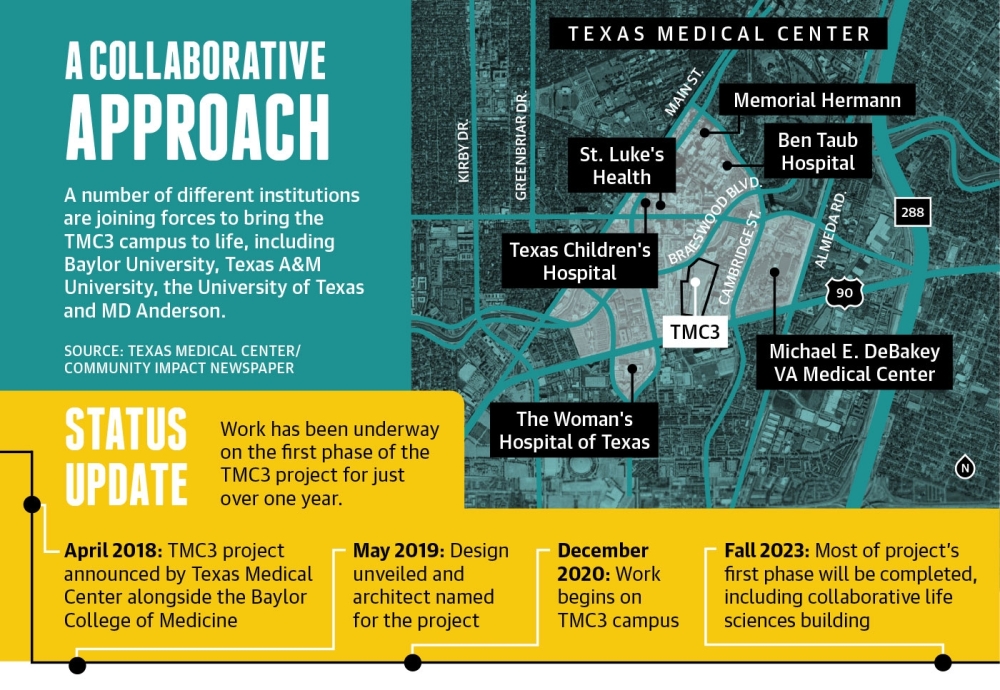Although Houston is already known for its health care offerings, the 37-acre TMC3 project brings a new collaborative, educational element to the city that could help it parallel Harvard University in Boston and the University of California, San Francisco in Silicon Valley, said Torrey Adams, senior director of life sciences with the Greater Houston Partnership.
“This is certainly in line with the pathway to create this third coast in the life sciences and health care [industry],” Adams said.
The new addition to the medical center is being built between Bertner Avenue and Staffordshire Boulevard just south of Brays Bayou, according to a master plan released by the TMC. A groundbreaking was held last fall, although construction has been ongoing since December 2020.
The project is being funded by various sources. TMC invested $40 million into a collaborative building, while each partner institution contributed $36 million, TMC’s Chief Operating Officer Isaac Middleton said. Other parcels are being funded by bonds, he said.
“Each of the tenants of the parcels pay into that,” he said.
Ongoing construction
The TMC3 land is slated to become one of the largest collaborative life sciences research facilities in the nation, according to the TMC. The effort is being led by five founding members: the Baylor College of Medicine, Texas A&M University Health Science Center, The University of Texas Health Science Center, The University of Texas M.D. Anderson Cancer Center and the Texas Medical Center.
Construction efforts are broken into two phases. Phase 1 includes a 50,000-square-foot mixed-use facility; a 521-room hotel and a 350-unit residential tower; a building for member institutions; and the first of four industry buildings, which will house research labs, office space and shared common areas.
“You haven’t seen anything like this done where you have multiple buildings and parks being built at the same time for different entities,” said Kristen Kupperman, TMC’s director of campus operations.
Phase 2, a timeline for which has not been announced, includes the Baylor St. Luke’s Medical Research Center and the new Baylor College of Medicine School.
The TMC3 Collaborative Building started going up in June and should be the first building to reach completion by August 2023, said Mark Sardegna, an architect with Elkus Manfredi, the firm hired to design the campus.
Woven in between the buildings are the planned Helix Gardens. The proposed 300,000 square feet of outdoor area will be assembled into five public parks linked in a double helix formation.
“The vision for the park is to: one, catalyze that live work play that we think is really important, and two, draw people out of the building,” Middleton said. “We think the best ideas are created in happenstance and unplanned collisions.”

Impact on Houston
The Texas Medical Center expects nearly 30,000 new permanent jobs to become available over the next seven years as a result of the project, including 23,000 in Harris County specifically, Middleton said. Additionally, more than 17,000 construction jobs have already materialized, generating approximately $3.25 billion across Houston.
“Clinicians, scientists and entrepreneurs will benefit from a resource-rich location accelerating new therapies, medicines, discoveries, and technologies to market and ultimately directly to the patients who most need them,” Thomas Luby, director of Texas Medical Center Innovation, said in a statement.
The project is expected to bring in $5.5 billion worth of investment in total to the state, Middleton said. Adams said he has been a part of several site visits with companies that are considering relocating to the area, including organizations he said would have never considered Houston before the TMC3 was announced.
“It probably is going to bring more jobs than even we are projecting,” Adams said.
Collaboration is key
The goal of TMC3 is to foster a collaborative environment, officials said.
Within the TMC3 Collaborative Building, four of the founding members—MD Anderson, Texas A&M University Health Science Center, the University of Texas Health Science Center at Houston and the TMC—will be provided a synergetic house for research, according to project plans.
What sets the site apart from similar life sciences projects in other major U.S. cities is the collaborative effort, Adams said.
Historically, the Houston health care sector can be characterized by different entities operating in silos, Adams said. The new project opens the door to smaller commercial enterprises that may have previously encountered barriers to working in the TMC, he said.
“No one is feeling like, ‘I’d never be able to set up shop in that area,’” Adams said of how the new project changes the TMC. “Now I have the support; I have the space. I have all of the things now that have been existing in the TMC, and I get to add mine to it.”
Dr. Giulio Draetta is the chief science officer of The University of Texas MD Anderson Cancer Center, one of TMC3's four founding institutions. He said project's collaborative elements make it a "unique nexus of academic and industry engagement."
MD Anderson will use the new space to conduct high-impact research, and being able to collaborate with other entities at the site will accelerate how quickly research discoveries can be translated into real-world health outcomes, Draetta said.
"TMC3 will connect MD Anderson’s north and south campuses, facilitating a streamlined approach to translational research," Draetta said in email comments. "TMC3 represents a quantum leap in the local life sciences ecosystem, and we look forward to being part of the exponential growth and collaboration that TMC3 will enable."






